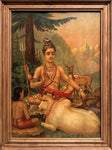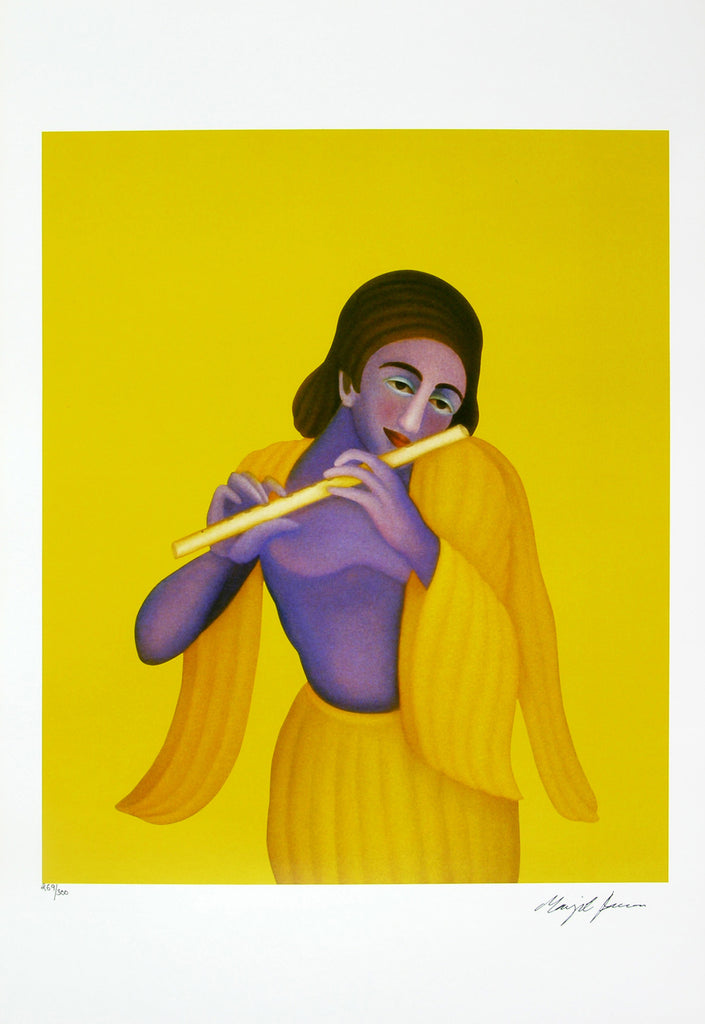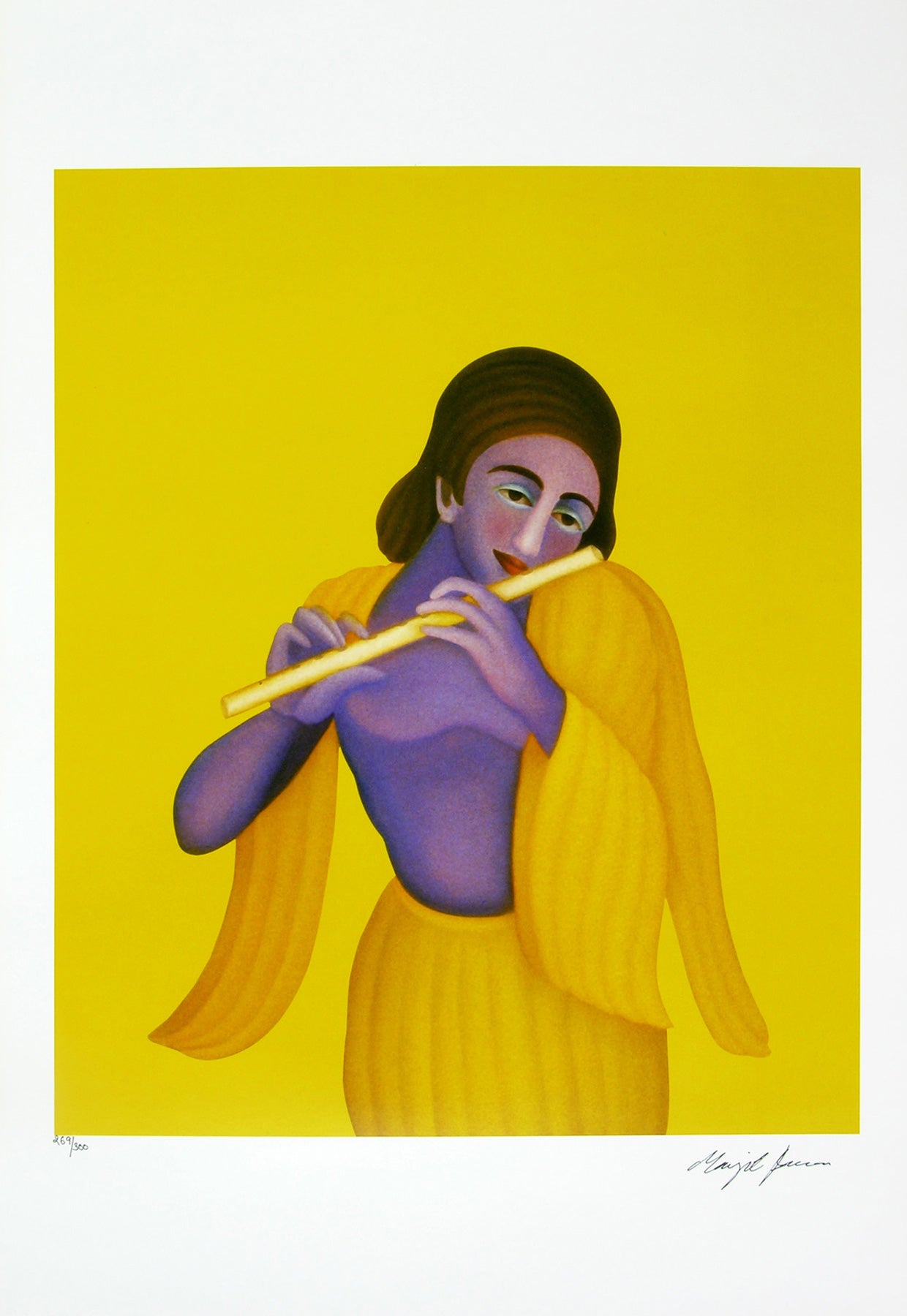- Home
- Bhavna - IV
Loading...
Bhavna - IV
by Manjit BawaAll orders are insured for transit.
We ship worldwide.
All orders are insured for transit.
We ship worldwide.
Details
| Size: | 20 x 14 inches (Paper Size) |
| Medium: | Offset Print on Paper |
| Year: | 2000 |
| Provenance: | Signed by the Artist |
| Edition: | Edition of 300 |
-
ABOUT Manjit Bawa
Read MoreBorn in 1941 in Dhuri, Punjab, Manjit Bawa is one of India’s most acclaimed artists. Encouraged heavily by his older brothers to pursue art, Bawa studied at the Delhi College of Art from 1958-1963 under eminent modern artists such as Somnath Hore, Dhanraj Bhagat and B.C. Sanyal. But it was Abani Sen who had a huge influence on Bawa, pushing him towards figurative work when others were leaning towards abstract. Sen made Manjit Bawa sketch constantly, and that practice made him develop his own distinct style, which is recognizable even today. Bawa went to London in 1964 where he worked as a silkscreen printmaker while also studying art. During that time, he managed to land solo exhibitions in London as well as Spain.
In 1972, he returned to India. Rejecting European influences, Manjit Bawa was one of the few artists of his time who used distinctly Indian colours such as bright pink, red, blue, sunflower yellow, green, and violet. Nature, birds and animals occurred frequently in his paintings, along with mythological characters such as Krishna, Kali and Shiva, and also Ranjha, from the tragic epic Heer Ranjha. Bawa was deeply spiritual and a believer of Sufi philosophy. His crisp, allegorical paintings were featured at Biennales in Japan, Turkey and Cuba. He also participated in many significant group shows in Amsterdam, Singapore, London, Mumbai and Paris.
While known for his vibrant paintings, Manjit Bawa loved drawing and sketching. He passed away in December 2008 at the age of 67, after being in coma for three years post suffering a stroke. Bawa’s paintings have fetched millions of dollars at auctions in both Indian and abroad.
-
ABOUT Limited Edition Prints
Read MoreLimited Edition Prints are a series of identical prints of an artwork, commissioned by the artist. Restricted to a one-time printing of a certain number of pieces, each print is numbered and signed by the artist, establishing its’ authenticity.
Because the number of prints is limited, signed prints of acclaimed artists hold value, and can be investment-worthy, just like original works of art. Christie’s and Sotheby’s – the world’s two most renowned auction houses – hold auctions exclusively for prints. A Pablo Picasso print sold for US$1.7 million in 2010!
There are different techniques in printmaking, including offset printing, digital printing, giclée, lithography and serigraphy. Serigraphy, or silk screen printing is considered one of the most sophisticated techniques. In this process, thick, opaque colours are passed through the screen, creating prints with vibrant colours and beautiful textures, that make the artwork look like a painting.
Works by any artist are limited, and prints are a fantastic way for acclaimed artists, to make their art available to a larger number of people. This makes limited edition prints popular amongst new art buyers as well as seasoned art collectors.
-
Details
Size: 20 x 14 inches (Paper Size) Medium: Offset Print on Paper Year: 2000 Provenance: Signed by the Artist Edition: Edition of 300 AUTHENTICITY
This artwork is accompanied by an Authenticity Certificate.
-
Returns
We accept returns within 7 days of delivery if the item reaches you in damaged condition.CARE INSTRUCTIONS
Prints and serigraphs on paper are best framed with regular or non-reflective glass. Artworks should be displayed away from direct sunlight and breeze. To clean any accumulated dust, use a soft, dry brush or cloth very lightly on the glass surface or the frame. Make sure there is no moisture on the brush or cloth before cleaning the surface. Once a year, remove the artwork from the wall for a couple of days to let the wall breathe and avoid moisture accumulation. -
Shipping
Shipping costs included for destinations in India.All orders are insured for transit.
We ship worldwide.
CARE INSTRUCTIONS
Read MorePrints and serigraphs on paper are best framed with regular or non-reflective glass. Artworks should be displayed away from direct sunlight and breeze. To clean any accumulated dust, use a soft, dry brush or cloth very lightly on the glass surface or the frame. Make sure there is no moisture on the brush or cloth before cleaning the surface. Once a year, remove the artwork from the wall for a couple of days to let the wall breathe and avoid moisture accumulation.
This item has been added to your shopping cart.
You can continue browsing
or proceed to checkout and pay for your purchase.
This item has been added to your
shopping cart.
You can continue browsing
or proceed to checkout and pay for
your purchase.
This item has been added to your wish list.
You can continue browsing or visit your Wish List page.
Are you sure you want to delete this item from your Wish List?
Are you sure you want to delete this
item from your Wish List?


















































































 View Full Screen
View Full Screen



